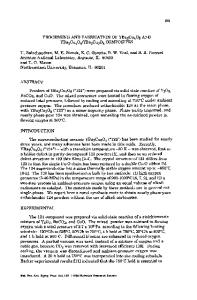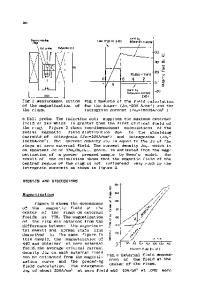Schottky Anomalies in the Low-Temperature Specific Heat of YBa 2 Cu 3 O y HTSC
- PDF / 846,180 Bytes
- 8 Pages / 612 x 792 pts (letter) Page_size
- 20 Downloads / 403 Views
DISORDER, AND PHASE TRANSITION IN CONDENSED SYSTEM
Schottky Anomalies in the Low-Temperature Specific Heat of YBa2Cu3Oy HTSC L. G. Mamsurovaa,*, N. G. Trusevicha, S. Yu. Gavrilkinb, I. V. Mamsurova, and L. I. Trakhtenberga,c,** a Semenov b
Institute of Chemical Physics, Russian Academy of Sciences, Moscow, 119991 Russia Lebedev Physical Institute, Russian Academy of Sciences, Moscow, 119991 Russia c Moscow State University,Moscow, 119991 Russia *e-mail: [email protected] **e-mail: [email protected] Received August 9, 2018; revised November 2, 2018; accepted November 8, 2018
Abstract—The evolution of the Schottky anomalies in the temperature dependence of the specific heat (in the temperature range T = 2–10 K and the magnetic field range H = 0–9 T) of polycrystalline YBa2Cu3Oy HTSCs is studied when the oxygen content in coarse-crystalline samples changes and when the degree of structural disordering in optimally doped fine-crystalline samples of the same compound changes. The number of paramagnetic centers with uncompensated spin moments, which generate the Schottky anomalies, and the splitting of the lower energy levels are estimated. A correlation between these parameters and both the number of oxygen vacancies in chain planes and the method of oxygen ordering in chains is found. The experimental data are compared with the results of studying the magnetic susceptibility at T > Tc in the same samples. Based on this comparison, we can conclude that the nature of the Schottky centers is related to the formation of paramagnetic centers at breaks in the Cu1–O4 copper–oxygen chains in the basal planes of the crystal structure. DOI: 10.1134/S1063776119030099
1. INTRODUCTION Cuprate HTSCs are known to be d-wave superconductors, which means that their gap function has nodes at the Fermi surface where the superconducting gap tends toward zero. As a result, some quasiparticle states near the nodes can be reached at the lowest temperatures and determine an electronic contribution to the specific heat. Thus, the study of the low-temperature specific heat of HTSC gives direct bulk information on the behavior of the superconducting gap near the nodes and, hence, is of special interest. In particular, low-temperature specific heat turned out to be helpful for solving the problem of identifying the d-wave pairing symmetry in HTSC [1]. The earlier investigations (see, e.g., [2, 3]) of the low-temperature specific heat of YBa2Cu3Oy HTSC showed the presence of various electronic contributions to the specific heat along with lattice contributions. The node contributions of low-energy excitations were of deep interest. A finite slope of the Vlike gap near the nodes was found to cause a linear dependence of low-energy density of states N(ε) ∝ |ε – εF|. As a consequence, the specific heat at temperature T → 0 K in the absence of a magnetic field turns out to be proportional to αT2. In a sufficiently strong mag-
netic field, the quadratic term αT2 is suppressed and replaced by another temperature-linear node term AV H T, where AV
Data Loading...











